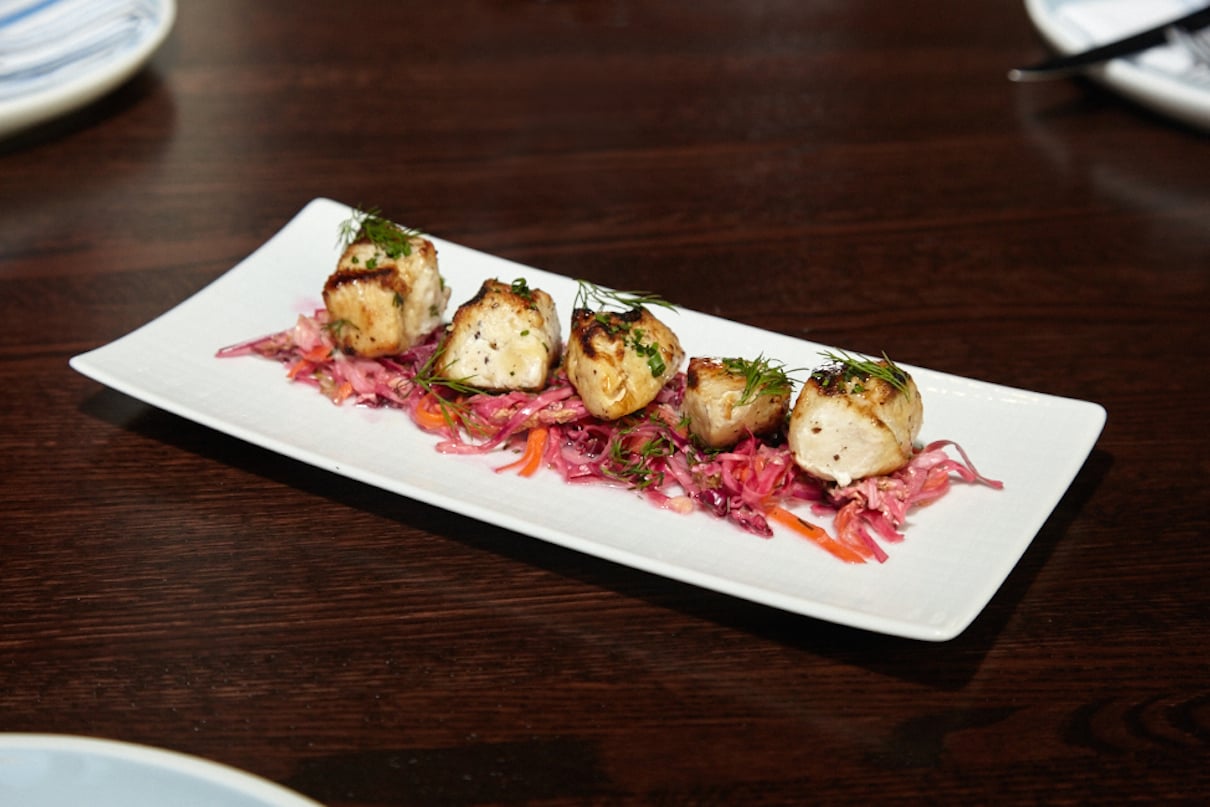This article is from 2006's Thanksgiving Dining Guide. To see 2007's guide, click here.
Like no other meal, Thanksgiving dinner presents challenges in wine pairing. There’s an array of foods—salty, sweet, earthy, smoky, creamy, acidic—and then there’s Aunt Ethel, who drinks only white Zinfandel.
Having several different wines open is the safest solution, but if you open only one or two, you’ll need something with good acidity and fruit. I asked a dozen chefs what one wine they would serve this year and got some eclectic answers.
Chef Jamie Stachowski of Restaurant Kolumbia believes the best hope for withstanding Thanksgiving’s onslaught of richness is a sparkling white wine; he favors a 2004 Domaine de Martinolles Cremant de Limoux. With 60 percent Mauzac, 20 percent Chardonnay, and 20 percent Chenin Blanc, this wine relies mainly on its fizz to cut through the moderate fat of Stachowski’s turkey, which he’s going to brine, stuff, and roll into a ballotine and serve with chestnut puree, cranberry-kumquat sauce, creamed ruby pearl onions, and haricots verts.
Regine Palladin, the longtime owner of Pesce, also favors a lighter-bodied wine so as “not to overwhelm the relatively mild flavors of turkey and ham,” but she’s going with a red: the 2005 Domaine des Nugues Beaujolais-Villages. Made from 100 percent Gamay, this charmer has bright fruit flavors to perk up the milder dishes and enough structure to hold its own with the more robust courses made with sausage and herbs.
Chef R.J. Cooper of Vidalia is also partial to Beaujolais-Villages, but “given that Thanksgiving is a New World holiday,” he says, “I’m choosing a 2004 Brick House Gamay Noir from Oregon’s Willamette Valley this year.” Cooper will be making a wild turkey, with a leg confit stuffed with sweetbreads and chestnuts, and is counting on the “ripe dark fruits and mild peppery spice to complement the gaminess of the meal.”
A relatively light-bodied red wine also appeals to Carole Greenwood, chef at Buck’s Fishing & Camping. Her pick is a Cabernet Franc: the 2005 Domaine du Pas Saint Martin “La Pierre Frite” Saumur Rouge from the Loire Valley. The Saumur, she says, is versatile enough to please “the entire Heinz 57 variety of characters sitting around my table,” on which she’ll place turkey with sausage stuffing, Brussels sprouts with pecans and shallots, and a creamy pumpkin-sage soup.
Ron Tanaka, the talented sous chef at CityZen, is also going with a Cabernet Franc from the Loire Valley—the 2004 Charles Joguet “Clos de la Cure” from Chinon, which, Tanaka says, “has the same flexibilities as a rose: It’s fine with or without food and has enough backbone to stand up to both giblet gravy and your in-laws.”
Nothing so simple as giblet gravy will be on the table at Fabio Trabocchi’s house. The chef at Maestro will serve his turkey two ways and has chosen a different wine for each presentation. For a first course, he’s going to oven-roast the breast until it’s slightly pink, slice it thin, and serve it at room temperature on a salad of baby butter lettuce and shavings of Alba white truffle. With this Trabocchi will be pouring a dry white wine with a touch of oak, the 2004 Isole e Olena Chardonnay, Collezione de Marchi. For the main course Trabocchi will stuff the legs with foie gras, roast them, then carve them tableside, spooning a sauce of port and black truffle on top. “The 2003 Elio Grasso Barbera d’Alba is perfect with this,” he says, “with a long rich finish, soft tannins, and a taste of black currants.”
“With turkey, I’m partial to Pinot Noir,” says Ann Cashion of Cashion’s Eat Place, “and something from the 2003 vintage is ideal.” 2003 was when a record heat wave swept through France, and as a result the grapes in Burgundy were bursting with ripeness during harvest. Cashion likes the 2003 Domaine Matrot Volnay Santenots, “since Matrot is a winemaker who really seeks to emphasize earthiness in his Pinots, combining the beautiful cherry fruit of Volnay with depth and complexity.”
Nadine Brown of Charlie Palmer Steak, the only sommelier in this survey, is also tapping a Pinot Noir for Thanksgiving. Like Cooper, she prefers a domestic wine for this American holiday. “Ted Lemon of Littorai is one of America’s most talented winemakers,” Brown says, “and his 2001 Littorai Savoy Vineyard, from Anderson Valley, is fall in a bottle. This underappreciated region in Mendocino County produces aromatic, classic Pinot Noir that has better balance than most Napa or even Willamette Valley Pinots.”
Antonio Burrell, whose cooking at Viridian leans toward the austere and refined, turns to his Southern roots during Thanksgiving. He’ll serve squab instead of turkey, supplementing the bird with bacon-intensive side dishes of collard greens, black-eyed peas, and Brussels sprouts that “cry out for a 2003 Hendry Block 4&5 Pinot Noir. This wine is tannic yet supple and does very well with the smoky, rich flavors found in foods cooked in bacon fat.”
“I normally have about six different wines going at once,” says Michael Hartzer, the chef at Ray’s the Classics—“a Gewurztraminer, a Riesling Spatlese, maybe a Pinot Gris from Oregon.” This year, Hartzer will be uncorking a bottle of 2003 Numanthia Termes, a lush Tempranillo from the Toro region of central Spain—grown at a 7,500-foot elevation on 70-year-old vines. “The Termes,” he says, “is an excellent choice for turkey or duck and has the earthiness to counterbalance the often-sweet side dishes.”
With gamey, fattier cuts of meat, you can’t miss by turning to the bold, assertive reds from the Rhone Valley. Jon Mathieson, chef de cuisine at 2941, will make a roast saddle of Millbrook venison this year along with caramelized chestnuts, sweet potatoes, applewood-smoked bacon, pearl-onion fricassee, and sauce poivrade . How does he plan to harmonize all those flavors? With a bottle of 2004 Domaine du Tunnel Cornas. “This Syrah is a great autumn wine, and I love how it tastes with the spiced venison. It’s intensely flavored without being heavy and has wild, brambly fruit flavors that emphasize the wild flavors of the meat. It also smells like bacon, which matches well with the sauce.”
Barry Koslow, the new chef at Mendocino Grille, has been sweating the details of Thanksgiving for months. No wonder: His Danish mother-in-law is coming to town. They’ll be having flaskesteg —a traditional, fresh ham stuffed with prunes and served with crispy cracklings of skin, caramelized potatoes, and pickled cabbage. “It’s rustic, comforting, and makes a killer sandwich the next day,” says Koslow. He’ll be opening a 2003 Domaine du Pegau Chateauneuf-du-Pape, Cuvee Reserve, which has “red cherries, blackberries, and soft tannins. I love fruit with ham,” says Koslow. “I just hope I don’t spill any on the couch while I’m watching the Cowboys lose.”

















